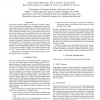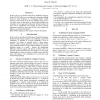116
click to vote
AAAI
2012
13 years 2 months ago
2012
Twitter sentiment analysis (TSA) has become a hot research topic in recent years. The goal of this task is to discover the attitude or opinion of the tweets, which is typically fo...
CIKM
2011
Springer
14 years 5 days ago
2011
Springer
We investigate temporal resolution of documents, such as determining the date of publication of a story based on its text. We describe and evaluate a model that build histograms e...
213
click to vote
ICASSP
2011
IEEE
14 years 3 months ago
2011
IEEE
Deep Belief Networks (DBNs) are multi-layer generative models. They can be trained to model windows of coefficients extracted from speech and they discover multiple layers of fea...
106
click to vote
ICASSP
2011
IEEE
14 years 3 months ago
2011
IEEE
We describe a new approach for rescoring speech lattices — with long-span language models or wide-context acoustic models — that does not entail computationally intensive latt...
104
click to vote
ICASSP
2011
IEEE
14 years 3 months ago
2011
IEEE
Local business voice search is a popular application for mobile phones, where hands-free interaction and speed are critical to users. However, speech recognition accuracy is still...
105
Voted
ICASSP
2011
IEEE
14 years 3 months ago
2011
IEEE
Language models for speech recognition tend to be brittle across domains, since their performance is vulnerable to changes in the genre or topic of the text on which they are trai...
79
Voted
ICASSP
2011
IEEE
14 years 3 months ago
2011
IEEE
Model M, a novel class-based exponential language model, has been shown to significantly outperform word n-gram models in state-of-the-art machine translation and speech recognit...
ICASSP
2011
IEEE
14 years 4 months ago
2011
IEEE
We describe the Arabic broadcast transcription system elded by IBM in the GALE Phase 4 machine translation evaluation. Key advances over our Phase 3.5 system include improvements ...
77
Voted
ICASSP
2011
IEEE
14 years 4 months ago
2011
IEEE
In this work we present the Subsequence Similarity Language Model (S2-LM) which is a new approach to language modeling based on string similarity. As a language model, S2-LM gener...
ICASSP
2011
IEEE
14 years 4 months ago
2011
IEEE
The use of statically compiled search networks for ASR systems using huge vocabularies and complex language models often becomes challenging in terms of memory requirements. Dynam...


